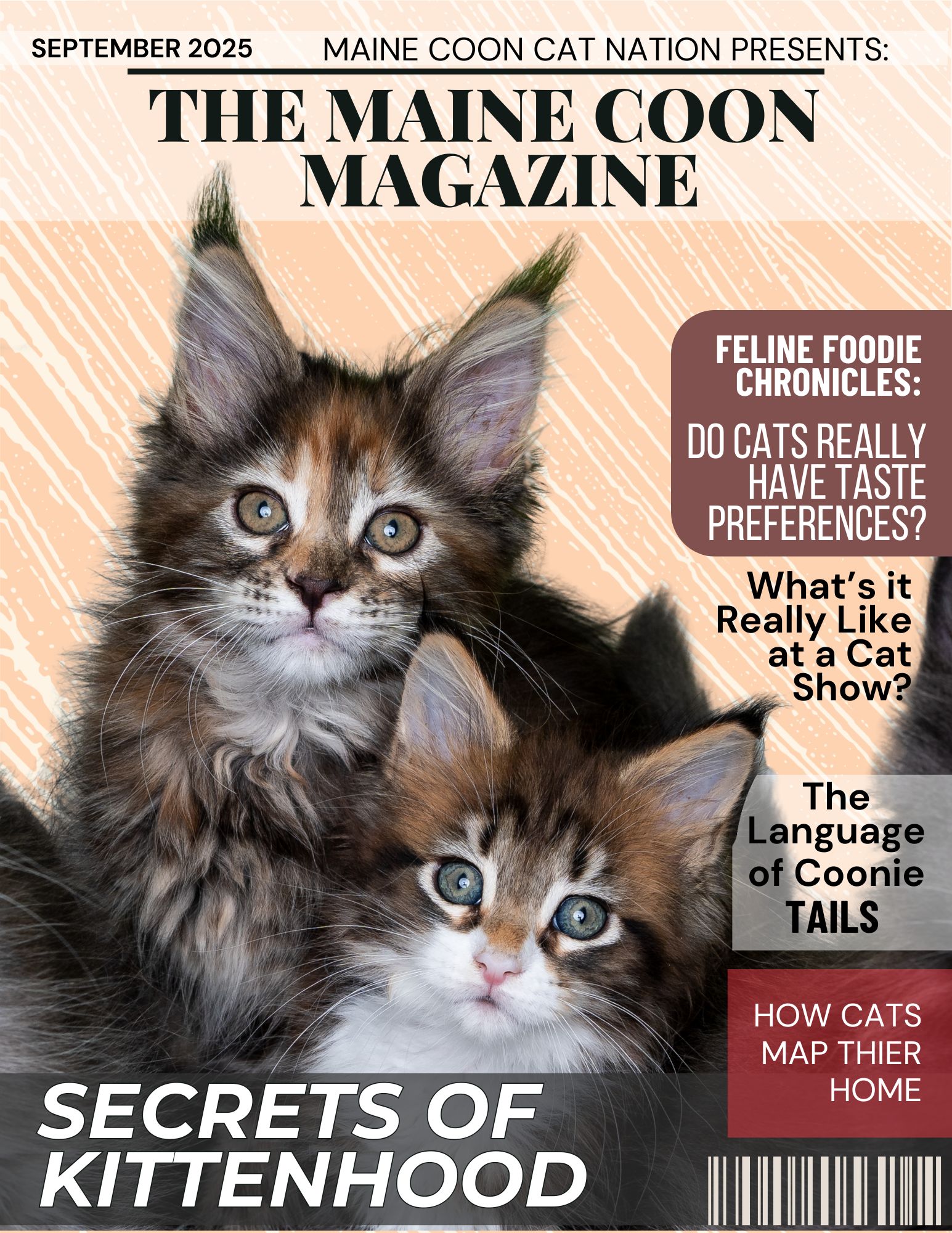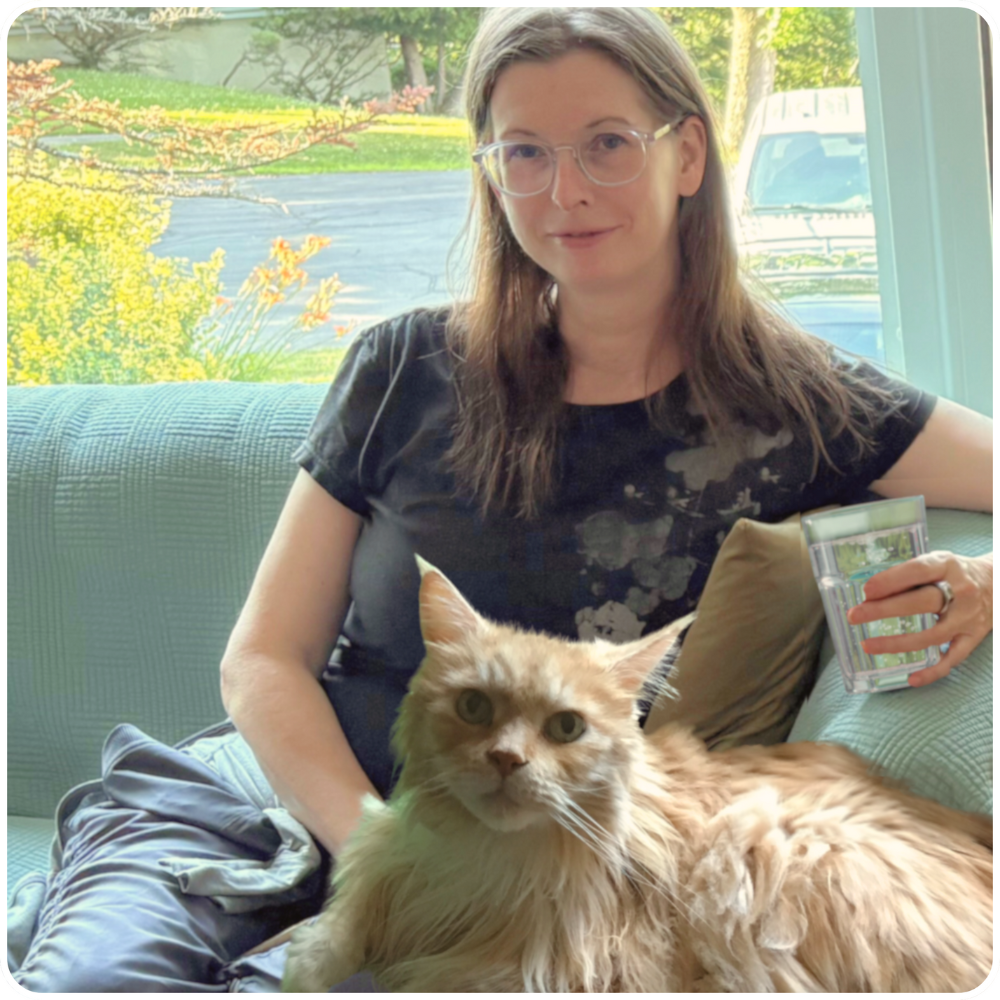- Home
- Maine Coon Cat Breed
- American Style
American Maine Coon Style vs European Aesthetic
•
Is There an "American" Maine Coon Style?
When you isolate the American Maine Coon style, you're really talking about the original lineage and aesthetic that developed in the U.S. before the European (and later Russian) influence began emphasizing more extreme features.
If you like this, you'll love our fun, free Daily Digest!

Here's a breakdown of what defines the American Maine Coon style:
Genetic and Lineage Roots
American lines trace back to foundation cats bred primarily in the northeastern U.S. (Maine, New York, Pennsylvania).
Early breeders focused on temperament, health, and utility.
Think of cats that could thrive in harsh New England climates and coexist as affectionate household companions.
- These lines are often less "engineered" in appearance.
- Many pedigrees go back to the 1960s-1980s, before widespread import of European studs.
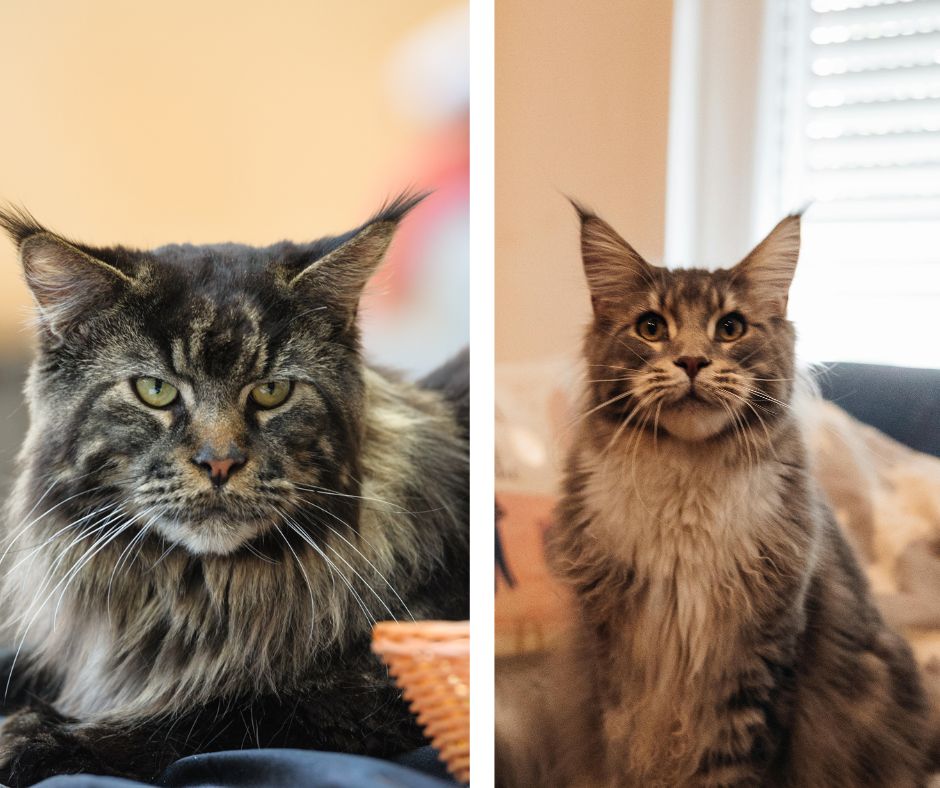 European Look & American Maine Coon Style
European Look & American Maine Coon StyleFacial Structure and Expression
This is one of the most visible differences:
|
Feature |
American Lines |
Russian/European Lines |
|
Muzzle |
Softer, shorter, less squared |
Elongated, boxy, pronounced |
|
Ears |
Medium-to-large, moderate lynx tips, wider set |
Tall, upright, large with long lynx tips |
|
Eyes |
Rounder or almond-shaped, gentle expression |
Deep-set, slightly slanted, intense "wild" look |
|
Overall Face |
Balanced, natural proportions |
More angular, sculpted "feral" appearance |
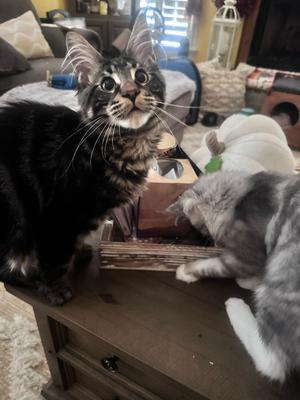 Young Oberon, from our Silvers and Smokes Album has that boxy muzzle
Young Oberon, from our Silvers and Smokes Album has that boxy muzzleThe American expression is sometimes described as sweet or thoughtful, compared to the "wild" intensity of modern European lines.
Coat and Build
American Maine Coons typically show:
- Coat: Silky to medium shaggy, rather than the dense, wooly texture common in Russian/Euro lines.
- Color: A wide range. Breeders in the U.S. historically selected more for personality than color uniformity.
- Body Type: Balanced and athletic, not as long in the torso or extreme in features. The chest is broad but not barrel-shaped.
- Tail: Long and flowing, but proportionate, not the exaggerated plumes sometimes bred for in show-focused European lines.
Temperament Focus
American breeders traditionally selected for easygoing, people-oriented cats rather than appearance extremes.
- Many classic American catteries still emphasize the "gentle giant" personality over flashy looks.
- You'll often see these lines described as "family cats". They are adaptable, relaxed, and steady.
Show Standard Alignment
Interestingly, the CFA standard, which originated in the U.S., still aligns more closely with the American style:
- It rewards balance and proportion rather than exaggerated traits.
- European and Russian breeders tend to follow FIFe and WCF standards, which allow for stronger facial structure and a more "wildcat" look.
Modern Trends
Over time, even within the U.S., you'll find:
- Some breeders adopting imported lines to introduce sharper features.
- Others staying purely "American type," often marketing this as traditional or classic Maine Coon style.
The classic American Maine Coon look is essentially the breed's original identity: large, sturdy, expressive, but still natural.
What "Sweet-Faced Style" Suggests
The first time I heard this was around a decade ago, when a reader commented on a submission in our Photo Albums, pointing out that he was the "sweet-faced" style of Maine Coon.
 Leo could be called sweet-faced
Leo could be called sweet-facedThe term "sweet-faced style" can refer informally to what many call the classic or American style of the Maine Coon, though it's not a formal or universally defined term in breeding standards.
It's informal. There isn't a formal breed-standard definition for "sweet-faced" (in major registries such as the Cat Fanciers' Association or The International Cat Association) that uses that exact label.
It may be used variably. Different websites, breeders, and enthusiasts may apply "sweet-faced" a bit differently. Some might use it simply for kittens with soft expressions, others for particular lineage types.
It's not exclusively American style. Someone might call a Russian-style line "sweet-faced" if the individual cat happens to have a softer expression, so it doesn't guarantee lineage.
But if you're distinguishing American vs Russian style, you can use it as a helpful shorthand with some caveats.
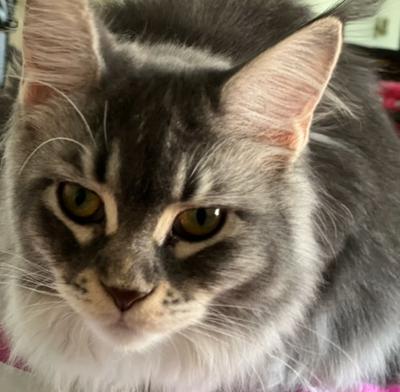 Queen Delphine has a sweet face
Queen Delphine has a sweet faceWhen a Breeder Says "Imported From Russia"
Often a breeder will post something like "introducing our new Russian stud we just had imported!" even when they aren't generally a Russian style breeder.
This is a really interesting (and increasingly common) phenomenon.
When a breeder in the U.S. or Canada announces "our new Russian import" or "Russian stud," it doesn't necessarily mean they're switching to the full Russian (or European) style of Maine Coon breeding.
It often means something a little more nuanced. Let's see what's really going on when you see those posts:
Why So Many American Breeders Import from Russia (or Europe)
There are several practical and aesthetic reasons breeders add an imported stud to their lines:
Genetic diversity:
The Maine Coon gene pool, especially among long-established American lines, can be relatively tight.
Importing a Russian or European cat helps broaden that genetic base, reducing inbreeding coefficients and strengthening long-term health.
 Milkman is from Russia
Milkman is from RussiaPedigree prestige:
Russian and Eastern European catteries have gained a reputation for exceptionally robust, striking cats.
Even a single imported stud can raise the perceived quality of kittens in the eyes of buyers who associate "Russian lines" with show-quality traits.
Feature blending:
U.S. breeders often want a touch of the Euro "wow factor" such as taller ears, a boxier muzzle, more bone mass, without going full feral or extreme.
So, they'll cross a Russian import with a softer American queen to keep a balanced, family-friendly look.
Appeal:
Let's be honest: "Imported from Russia" sounds impressive. It signals dedication, investment, and international connections. Many breeders note it in posts for credibility and intrigue.
What Usually Happens After the Import
Most of the time, these "new Russian studs" end up blending into a breeder's existing American-style program rather than transforming it.
- Visually: The kittens might gain slightly higher cheekbones or a more prominent muzzle, but still have the rounder eyes and balanced proportions of their American dam.
- Generationally: Within one or two generations, the Russian influence softens again unless the breeder keeps adding European stock.
In tone: The breeder might say things like "We love the structure this line adds, while keeping our sweet expressions."
That's exactly what they mean. They are adding a hint of definition, not changing their entire aesthetic.
How You Can Usually Tell They're Still American-Style
Even after importing, American-leaning breeders tend to:
- Keep CFA or TICA registration rather than WCF or FIFe (the latter are more Euro-Russian).
- Continue emphasizing temperament, family suitability, and "classic" looks in their kitten descriptions.
- Post photos where cats look balanced, soft-eyed, and natural, not dramatically angular or wolfish.
Use phrases like "traditional," "classic," or yes, "sweet-faced."
The Hybrid Look: Where Styles Overlap
At this point, a lot of American breeders have hybrid programs of maybe 75% U.S. lines with one or two imported studs or queens.
The result is often the best of both worlds:
- The soft, sweet face and silky coat of the American type.
- The structure and bone of Russian or European lines.
That balance of a natural, gentle look that still has presence is what many modern U.S. breeders are striving for.
More Nuanced Than it Seems
Like many things in life, if you were to ask a breeder "are your cats American style or Russian style?" it's more nuanced than a simple "American or Russian" checkbox.
Here's how that conversation usually really plays out under the surface:
It's Rarely Purely One or the Other
Most modern breeders, even those who lean strongly one way, have some mix in their cats' pedigrees.
Maybe they started with American lines years ago, then added a European queen to strengthen ear set or head shape. Or maybe they began with Russian imports but outcrossed with an American line to bring back a softer expression.
So if you asked, "Are your cats American or Russian style?" most would probably say something like:
"We're mostly traditional, but we've introduced a few European lines for balance," or "Our look is a blend. We like the structure of the Russian cats but keep the sweet expression."
Style Isn't Just About Geography
You could have:
- A breeder in Russia producing soft, sweet-faced cats (more American-style).
- A breeder in Texas focusing entirely on sharp-featured, Euro-type lines.
It's not where the cattery is, it's what aesthetic and traits they choose to emphasize.
That's why many serious breeders talk about their "type" rather than "region." "Type" refers to the cat's look, build, and feel.
Breeder Intent Plays a Huge Role
Different breeders have different goals:
- Show breeders might aim for that dramatic Euro look because it stands out in the ring.
- Pet-focused breeders often prefer the softer, more family-appealing American look.
- Some aim for a "balanced" or "moderate" style, wanting a little of both, such as strong bone and muzzle, but a warm, open expression.
So style is more of a continuum than a divide.
Even Within One Cattery, There's Variety
If a breeder has multiple studs and queens, you'll often see both types represented:
- Their queen line might be American, producing gentle, sweet faces.
- Their stud might be Russian, adding strength and structure.
Kittens from each pairing may lean one way or the other, which is why you see litter photos where one kitten looks "European" and its sibling looks "classic."
In Short
Asking "American or Russian style?" is a good starting point. It tells you the breeder's general aesthetic lean.
But the real answer usually sounds like:
"We have some Russian lines, but our focus is on maintaining that classic American look," or "Our cats are European type, though not too extreme. We like to keep the sweet expression."
It's a spectrum, not a label, and that's part of what makes Maine Coon lines so fascinating to follow.
Leaning Into an Aesthetic
Some breeders really lean into the European, or Russian style and are transparent with that. It's an exciting, wild and exotic look.
The "European" or "Russian" style has become a marketable aesthetic, while the "American" style is treated as the quiet default, almost invisible because it's the breed's original look.
Here's what's going on culturally inside the breeder world and why you're seeing that pattern:
On the flipside, others use a more diversified approach and don't really "talk about it." It's as if there isn't a specifically "American style."
In other words: they don’t come out and say "our cats are American style," but they may say they are balanced.
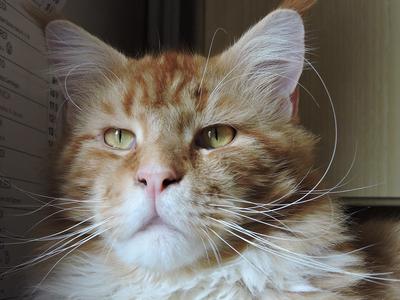 Zoran, with his strong muzzle and striking expression.
Zoran, with his strong muzzle and striking expression.The European (and Russian) Look Is a Brand Now
Breeders who specialize in that bold, feral expression often announce it proudly with phrases like:
"European lines," "Russian imports," "wild-type faces," "feral look," or "wolfish structure."
That style photographs beautifully. It's dramatic and instantly recognizable, and it gives breeders a clear visual identity in a crowded market.
For buyers scrolling social media, those sharper muzzles and high-set ears look exotic, so the marketing practically writes itself.
The American Style Doesn't Feel Like a 'Statement'
The original American look of rounder eyes, softer muzzle, and balanced build doesn't read as an alternative; it reads as "normal." It's the foundation the breed started from, so American breeders rarely declare it.
Instead, they use words like:
"Classic," "traditional," "moderate," or "balanced."
Those phrases quietly imply American-style features without naming them outright. It's almost as if saying "American style" would sound redundant or even defensive: "we're just breeding Maine Coons as they've always been."
It's Also About Tone and Culture
Russian and European breeders tend to frame their programs around type, which is a clear visual philosophy. Many American breeders frame theirs around temperament and home life.
So they might emphasize:
"Family-raised," "socialized with kids," "gentle personalities," instead of talking about cheekbones and muzzle structure.
That difference in tone feeds the perception that "European" equals style and "American" equals substance, even though both are equally deliberate breeding choices.
The 'Balanced' Label Bridges the Two
"Balanced" or "moderate" is the diplomatic middle ground. It lets a breeder say:
"We appreciate the strong features of the European lines,
but we don't want to lose the sweet expression."
It's a subtle way of signaling: we're not extreme either way. Many breeders who've added imports, but don't want their cats to look too wild, use that word as code for "light Euro influence on a traditional foundation."
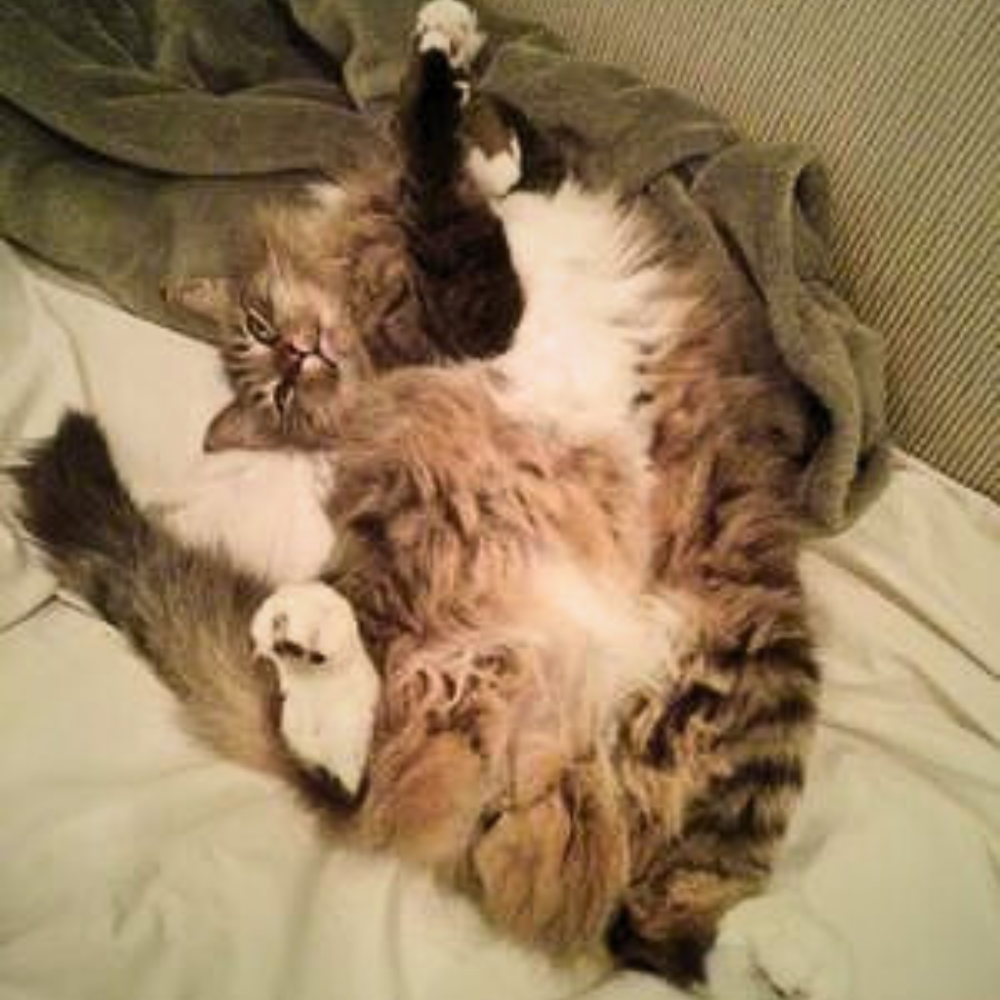 Regardless of features, Coonies are loaded with personality!
Regardless of features, Coonies are loaded with personality!The Irony
The original Maine Coon, the cat that earned the breed's reputation, is what people now call "American style." But because it's the baseline, it's not treated like a style at all.
Only when contrasted with the newer, more dramatic Euro types does it become "a look" again.
Takeaway
It's important to remember that regardless of features, the best breeders strive for health and temperament above all, and no matter what your Coonie looks like, they are an amazing, gorgeous family member.
At the end of the day, the whole "style" discussion is really about aesthetics and preference, not quality or worth. The best breeders, whether they lean European, Russian, American, or somewhere in between, are all chasing the same core priorities:
- Health: maintaining strong hearts, hips, and immune systems through responsible pairing and genetic testing.
- Temperament: raising kittens that are confident, affectionate, and well-socialized.
Everything else: ear set, muzzle shape, coat length, is secondary to those fundamentals.
And for owners, that's the real takeaway: your Coonie's look might hint at their lineage, but it doesn't define their value or personality.
Whether your cat has a boxy muzzle and towering ears or a soft, rounded face and silky coat, they're still unmistakably a Maine Coon. An intelligent, loyal, playful, and cherished part of the family.
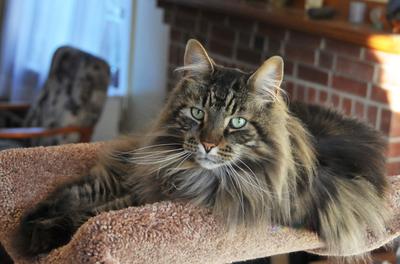 Little Bear
Little BearLearn more in our Maine Coon Breed section - from history and standards to fun facts and myths.
